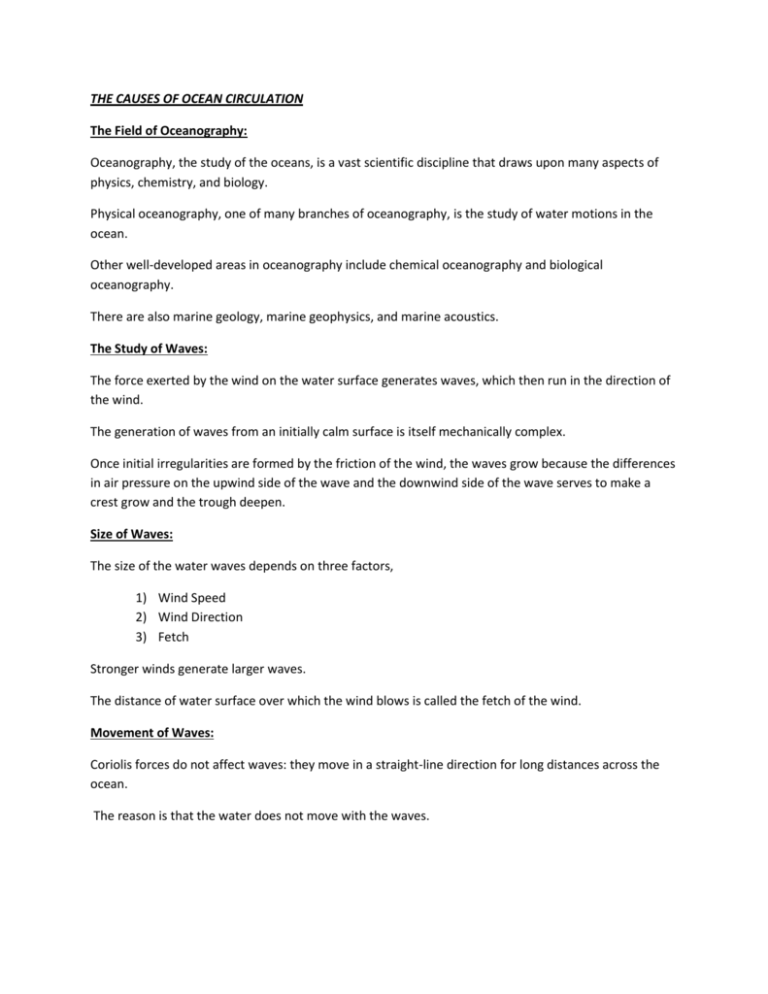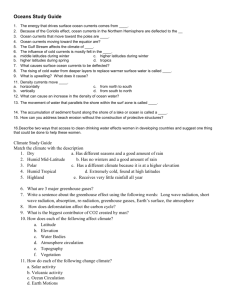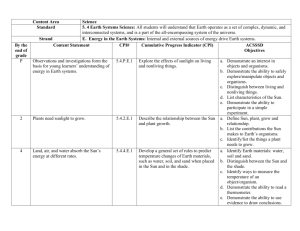Ocean Chapter Notes
advertisement

THE CAUSES OF OCEAN CIRCULATION The Field of Oceanography: Oceanography, the study of the oceans, is a vast scientific discipline that draws upon many aspects of physics, chemistry, and biology. Physical oceanography, one of many branches of oceanography, is the study of water motions in the ocean. Other well-developed areas in oceanography include chemical oceanography and biological oceanography. There are also marine geology, marine geophysics, and marine acoustics. The Study of Waves: The force exerted by the wind on the water surface generates waves, which then run in the direction of the wind. The generation of waves from an initially calm surface is itself mechanically complex. Once initial irregularities are formed by the friction of the wind, the waves grow because the differences in air pressure on the upwind side of the wave and the downwind side of the wave serves to make a crest grow and the trough deepen. Size of Waves: The size of the water waves depends on three factors, 1) Wind Speed 2) Wind Direction 3) Fetch Stronger winds generate larger waves. The distance of water surface over which the wind blows is called the fetch of the wind. Movement of Waves: Coriolis forces do not affect waves: they move in a straight-line direction for long distances across the ocean. The reason is that the water does not move with the waves. What Drives Water Movement in the Oceans?: With the exception of the tides, which do not figure importantly in this chapter, virtually all of the largescale water motions in the oceans are caused by global temperature differences, either directly or indirectly. The Hotter the surface, the stronger the radiation and the shorter the wavelength of the radiation. The circulation in the oceans consists of two largely separate parts: The deep circulation, which is driven directly by latitudinal temperature differences, and the surface circulation, which is driven by the Earth’s wind systems. These wind systems are in turn driven by the latitudinal temperature differences. The Coriolis Effect: The Earth’s rotation introduces great complexity to the circulation of the oceans, as well as to the Earth’s wind systems. In accordance with Newton’s First Law of Motion, once air in the atmosphere or water in the oceans are set in motion, they tend to move at constant speed and in a straight line, to the extent that they are not acted upon by frictional forces. Meanwhile, the Earth is rotating relative to that outer-space observer; moreover; it is rotating relative to the moving water. To an observer (i.e. to you) fixed upon the rotating Earth, the air and water seem to be moving in a curved path; in reality, however, it is you—not the air or water—that is moving in a curved path. The Coriolis force is not really a force: it is a consequence of viewing a moving body from a rotating frame of reference. Ocean Currents Affect Climate: There is a very close connection between ocean currents and climate, both global and local. The pattern of ocean surface currents is also a major factor in the climate of land areas of subcontinental size. The specific heat capacity of a material is a measure of how much heat must be added, per unit mass, to raise the temperature of the material by one unit. Warm ocean waters are the main suppliers of water vapor to the atmosphere. Most of the precipitation along the eastern seaboard of the United States, in both winter and summer, originates from the warm water of the Gulf of Mexico and western Atlantic. Climate Affect Ocean Currents: Climate can have a major effect on ocean circulation. The average deep ocean depth is four or five kilometers, the bottom of the deep ocean is a place of inky blackness, eternal cold, and water pressures that are unimaginably large, however even the deep oceans are shallow relative to the surface area covered by the oceans. The ocean is layered by temperature. The zone of rapid change from warm water to cold water with increasing depth is called the thermocline. Because cold water is more dense than warm water, this transition zone is also called the pycnocline. Warm , shallow parts of the ocean, above the thermocline, is in a state of continuous movement, or circulation. The cold, deep part of the ocean is also in a state of continuous circulation. Oceanographers have been describing the circulation of the ocean, and trying to develop theories to account for it, for over a hundred years. The circulation of the upper layer of the ocean is caused mainly by the friction force exerted on the ocean surface by the wind. One of the basic principles of physics is that a mass of material moves in a straight line at constant speed unless it is acted upon by some force. It takes a force to make a mass of material move in a curved path instead of a straight line. The force that seems to make the water or the pen point move in a curved path is called the Corilois force. Scientists use the word “counterintuitive” for things like this: your intuition tells you one thing, but the real-world situation shows you something very different. THE DEEP CIRCULATION OF THE OCEAN The Structure of the Ocean: The Oceans can well be described as absolutely deep but relatively shallow. Typical deep ocean depths are four to five kilometers. Currents in the Deep Ocean: Currents exist in the deep ocean worldwide, although these currents are generally much slower than typical surface currents. These currents originate by production of very dense ocean surface waters at high latitudes in both the Northern Hemisphere and the Southern Hemisphere. The density of the surface waters is increased in two ways: it is cooled, and its salinity is increased by freezing out of fresh-water ice. The water then sinks and flows slowly at or near the ocean bottom by circuitous routes to low latitudes. It then is warmed and rises up slowly to the surface, to be carried by surface currents back to highlatitude areas. Circulation Cell, Not Convection Cell: Oceans are both heated and cooled at the surface rather than from beneath. The key element that drives the deep circulation is vertical mixing through the water column at low latitudes. What Causes Vertical Mixing?: Tides are mainly responsible for the mixing, and therefore the existence of the deep circulation of the oceans. It is common misconception that the deep circulation, which is somewhat misleadingly called the thermohaline circulation, is convection: it is not Stratification of Water Masses in the Ocean: Oceans are stratified by density. The most prominent aspect of this stratification is the presence of a shallow surface layer of warm water that extends from the equatorial regions into mid-latitudes. At high latitudes, especially in winter, the cold layer extends all the way to the surface so there is no thermocline. The densest water in the ocean is produced around the Antarctic continent, especially in winter, by chilling of the water combined with freezing out of fresh-water surface pack ice, thus increasing the salinity. The Difficulties of Studying Ocean Currents: Objects floating with the currents at depth cannot easily be seen or detected. Speeds are commonly no more than a few centimeters per second, but under some circumstances per second, but under some circumstances they can be high as tens of centimeters per second. It has become clear in recent years as well that the currents are not steady; instead, they fluctuate in speed and direction on time scales of hours to weeks to years, much as the winds in the atmosphere. The Effect of the Coriolis Force: The Coriolis force fundamentally affects the pattern of deep ocean currents. The water in the oceans can sink, rise, or flow horizontally relative to the surrounding water. The horizontal movements of ocean water are called ocean currents. Ocean currents carry matter and energy from one part of the ocean to another. The surface currents flow much faster than the deep currents, but the deep currents affect a much greater thickness of the ocean. The movement of deep ocean water is controlled by the density of the water. The density of seawater is determined by two factors: temperature and SALINITY. Salinity is dissolved salts in seawater. The higher the salinity of ocean water is, the more dense the water is. When the salinity of a mass of water is increased, the water sinks relative to surrounding masses of water. Both are important, although temperature has a much greater effect than salinity on seawater density. Temperature- The Sun heats the Earth’s surface unequally, because the Sun’s rays strike the Earth from nearly overhead at low latitudes but at a very low angle at high latitudes. Because ocean water at high latitudes is also very cold, it is the most dense water in the worlds ocean. The ocean is a single body of water, but it is not the same everywhere. Both the temperature and the salinity of ocean water vary from place to place. Large regions of the ocean have water with about the same temperature and salinity, these are called water masses. Water masses are named from where they are formed. Antarctic Bottom Water is the most dense of all deep ocean water masses. These slow movements of the deep water masses from a gigantic and very complicated circulation cell that can take almost 1500 years to complete its cycle. This deep ocean circulation of the ocean might also be caused by the moon. THE SURFACE CIRCULATION OF THE OCEAN Surface Currents: The Ekman Drift: The frictional forces exerted by the wind produce surface currents. The highly counterintuitive result is that the net transport of water is at right angles to the wind direction! This is called the Ekman Drift. This represents a balance among three forces: the downward force of the wind; the Coriolis force; at right angles to the motion; and friction by the underlying water; acting opposite to the direction of movement. The phenomenon of the Ekman drift applies to long-sustained winds over areas of the ocean surface. The frictional forces exerted by the wind produce surface currents. Surface Currents: Gyres: One of the most prominent features of the pattern of surface ocean currents is the existence of large rotatory currents, called gyres, in the ocean basins. Floating Sneakers example for proof. The surface currents in the oceans account for almost half of the necessary transfer of heat. If there were no ocean surface currents, the atmospheric circulation would have to transfer more heat, resulting in a greater contrast in temperature between low latitudes and high latitudes. Currents at ocean depths down to 200 meters encompass about 10% of the water in the oceans. These currents flow for long distances across the oceans. They form enormous circulation cells, called gyres. These gyres circulates clockwise in the ocean basins of the Northern Hemisphere and counterclockwise in the ocean basins of the Southern Hemisphere. The gyres play a very important part in the Earth’s climate, because they help to transport heat energy from low latitudes, where the Earth is warmed by the Sun, to high latitudes, where the Earth’s surface loses heat to outer space. Easterlies(winds) blow from the East. Easterlies push water to the West and Westerlies push water to the East. Water moves in the oceans because it is acted upon by forces. The overall, movement of the water is at right angles (90 degrees) to the direction of the wind. The direction of the current is to the right of the wind in the Northern Hemisphere and to the left of the wind in the Southern Hemisphere. The surface Ekman drift causes the easterly trade winds to move water towards higher latitudes and causes the westerlies to move water towards lower latitudes. Upwelling is the upward movement of ocean water to the surface from deep in the ocean. As the water at the surface is pushed offshore, water from deeper down has to rise up to replace it. Everywhere in the oceans, even at low latitudes, the ocean is cold below the surface layer. Very near the Equator, where the Coriolis effect vanishes, winds blowing directly offshore cause upwelling, in just the way your intuition might suggest to you. At higher latitudes, however, offshore winds move water only along coasts, not away from them. Upwelling supports about half of the world’s fisheries, even though these cool waters account for only 10 present of the surface area of the world ocean. If the wind blows in the opposite direction, surface Ekman drift would then sink down under the added weight and be replaced by a surface flow of offshore water. This is the opposite of upwelling and is called downwelling.








